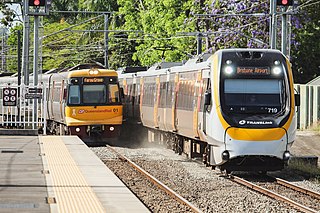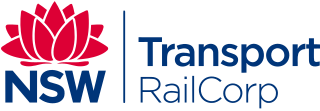
CityRail was a passenger railway brand operated by the State Rail Authority from 1989 to 2003 and by RailCorp from 2003 to 2013 with services in and around Sydney, Newcastle and Wollongong, the three largest cities in New South Wales, Australia. It was established in January 1989 and abolished in June 2013 when it was superseded by Sydney Trains and NSW TrainLink.

Rail transport in Australia is a component of the Australian transport system. It is to a large extent state-based, as each state largely has its own operations, with the interstate network being developed ever since Australia's federation in 1901. As of 2022, the Australian rail network consists of a total of 32,929 kilometres (20,461 mi) of track built to three major track gauges: 18,007 kilometres (11,189 mi) of standard gauge, 2,685 kilometres (1,668 mi) of broad gauge, and 11,914 kilometres (7,403 mi) of narrow gauge lines. Additionally, about 1,400 kilometres (870 mi) of 610 mm / 2 ft gauge lines support the sugar-cane industry. 3,488 kilometres (2,167 mi), around 11 percent of the Australian heavy railways network route-kilometres are electrified.

The Australian state of New South Wales has an extensive network of railways, which were integral to the growth and development of the state. The vast majority of railway lines were government built and operated, but there were also several private railways, some of which operate to this day.

Rail Corporation New South Wales (RailCorp) was an agency of the State of New South Wales, Australia established under the Transport Administration Act 1988 in 2004. It was a division under the control of Transport for NSW since the latter's establishment in 2011. RailCorp was converted into a state-owned corporation and renamed the Transport Asset Holding Entity (TAHE) on 1 July 2020.

The Southern Sydney Freight Line (SSFL) is a freight only railway line in the south-western suburbs of Sydney, Australia. The line was built to segregate freight trains from the Sydney Trains network. It forms part of a dedicated freight only corridor between Port Botany and Macarthur. The line is managed by the Australian Rail Track Corporation.

The State Transit Authority of New South Wales, also referred to as State Transit, was an agency of the Government of New South Wales operating bus services in Sydney. Superseding the Urban Transit Authority in 1989, it was also responsible for the provision of ferry services in Sydney until 2004 and bus and ferry services in Newcastle until 2017. It ceased trading after 2 April 2022 with its remaining operations to be contracted out by Transport for NSW to replacement operators. As of November 2024, the New South Wales Government has not yet put forward a Bill for the dissolution of the State Transit Authority of NSW.
Rail Infrastructure Corporation, later known as Country Rail Infrastructure Authority after July 2010, was a Government of New South Wales statutory corporation with responsibility for the management of the railway network in rural New South Wales, Australia.

Metro Transport Sydney (MTS) was the owner of the now-demolished Sydney Monorail and the former owner of the Inner West Light Rail in Sydney, New South Wales. Established in 2001, it replaced the Sydney Light Rail Company (SLRC), the previous owner of the light rail, and CGEA Transport Sydney, the previous owner of the monorail. It was bought by the New South Wales Government in 2012. The Metro Transport Sydney brand was discontinued from 1 July 2013, and the SLRC and Metro Transport Sydney were deregistered later that month.
The New South Wales Department of Planning and Environment (DPE) was a department of the New South Wales Government, responsible for effective and sustainable planning to support the growth in the state of New South Wales, Australia. It made plans based on evidence for the state's cities and regions, working with the community, business and local government to create places for people in NSW to live, work and spend their leisure time, while ensuring good access to transport and other services like shops and restaurants. The department was also responsible for the evidence-based assessment of state significant development applications.
The Transport Construction Authority (TCA), formerly Transport Infrastructure Development Corporation (TIDC) prior to July 2010, was an agency of the Government of New South Wales that was responsible for new railway projects in the city of Sydney, Australia. On 1 November 2011 the Transport Construction Authority was subsumed into the newly formed Transport for NSW.

An extensive multi-modal transport system serves the state of New South Wales, Australia. The lead government agency responsible for the network's operation and development is Transport for NSW.

One Rail Australia was an Australian rail freight operator company. Founded by a United States short line railroad holding company, Genesee & Wyoming Inc, in 1997 as Australian Southern Railroad, and successively renamed Australian Railroad Group and Genesee & Wyoming Australia, it was renamed One Rail Australia in February 2020 after the American company sold its remaining shareholding. In July 2022, assets from the South Australian, Northern Territory and interstate operations of the company were sold to rail operator company Aurizon Holdings Limited. The remaining assets, relating to coal haulage in New South Wales and Queensland, were sold in February 2023 to Magnetic Rail Group.

Port Botany is a deepwater seaport located in Botany Bay in Sydney, Australia. The port is dominated by trade in containerised manufactured products and, to a lesser extent, bulk liquid imports including petroleum and natural gas. It is one of Australia's largest container ports and is administered by NSW Ports which entered into a 99-year lease agreement with the Port Authority of New South Wales in May 2013.
NSW Maritime, the trading name of Maritime Authority of New South Wales, was an agency of the Government of New South Wales, Australia responsible for marine safety, regulation of commercial and recreational boating and oversight of port operations. The Authority had responsibility for marine incident investigation, including the causes of incidents involving shipping and commercial vessels and breaches of State or Commonwealth navigation laws. Incidents involving Sydney Ferries vessels are examined by the Office of Transport Safety Investigations, which is also responsible for investigations into incidents involving publicly owned rail and bus transport. The Authority was also responsible for property management of submerged lands in Sydney Harbour, Newcastle Harbour, Botany Bay and Port Kembla, and for providing strategic advice on ports and maritime matters to the NSW Government.

The Canberra Railway Museum is located at Kingston in the Australian Capital Territory next to Canberra railway station on the Bombala railway line. Since May 2018, Canberra Railway Museum has been the trading name of a not-for-profit company, Capital Region Heritage Rail Limited, established to run the museum, while ACT Heritage Rail Holdings Limited is the company responsible for safeguarding the heritage assets of the museum.

Transport for NSW (TfNSW) is a New South Wales Government transport services and roads agency established on 1 November 2011. The agency is a different entity to the NSW Department of Transport, which is a department of the state government of New South Wales, and the ultimate parent entity of Transport for NSW.

Sydney Trains is the brand name and operator of suburban and intercity train services in and around Greater Sydney in New South Wales, Australia.

Transport Heritage NSW is a body established by the Government of New South Wales to manage the state’s rail heritage collection and provide support to the broader transport heritage sector in NSW.

The New South Wales Metropolitan Rail Area (MRA) is the government-operated railway network centred on Sydney and bounded by Newcastle Interchange in the north, Bowenfels in the west, and Glenlee and Bomaderry in the south. The MRA contains the entirety of the state's electrified rail network. The MRA is owned by Transport Asset Holding Entity and maintained by Sydney Trains.

The Ingalara Creek railway bridge is a heritage-listed former railway bridge that carried the Bombala railway line across Ingalara Creek at Michelago in the Snowy Monaro Regional Council local government area of New South Wales, Australia. It was designed by John Whitton in his capacity as Engineer-in-Chief for Railways and built in 1889. It is also known as the Michelago Rail Bridge over Ingalara Creek and the Ingalara Creek Railway Viaduct. The property is owned by Transport Asset Holding Entity, an agency of the Government of New South Wales. It was added to the New South Wales State Heritage Register on 2 April 1999. On 1 December 2020, changes were made to exemptions relating to the bridge's heritage status.
















